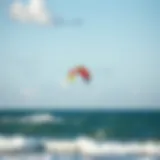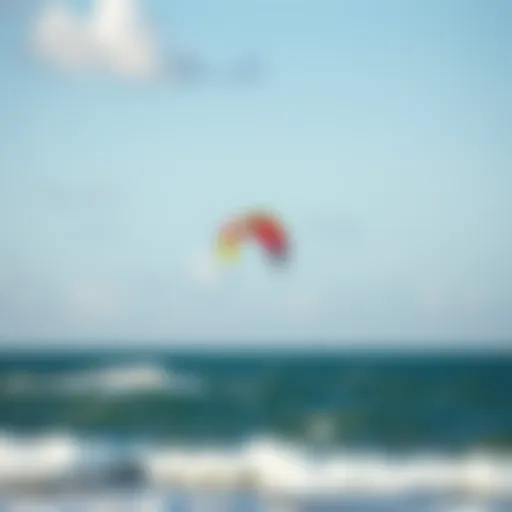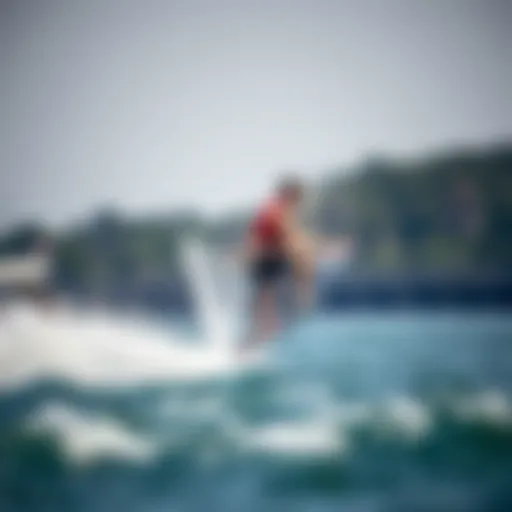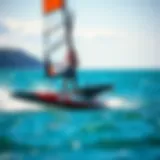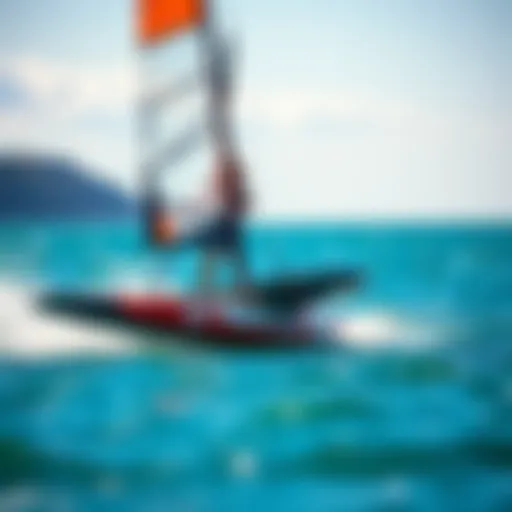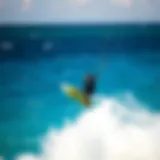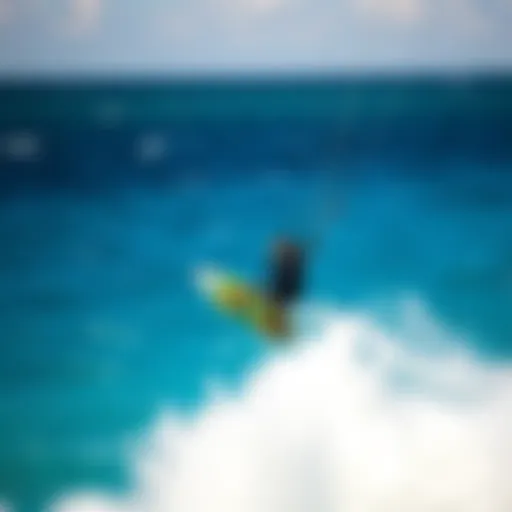Hydrofoil Technology in Kiteboarding: A Deep Dive
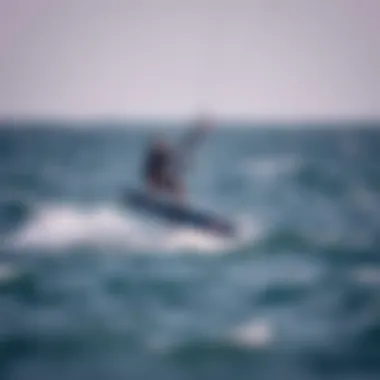
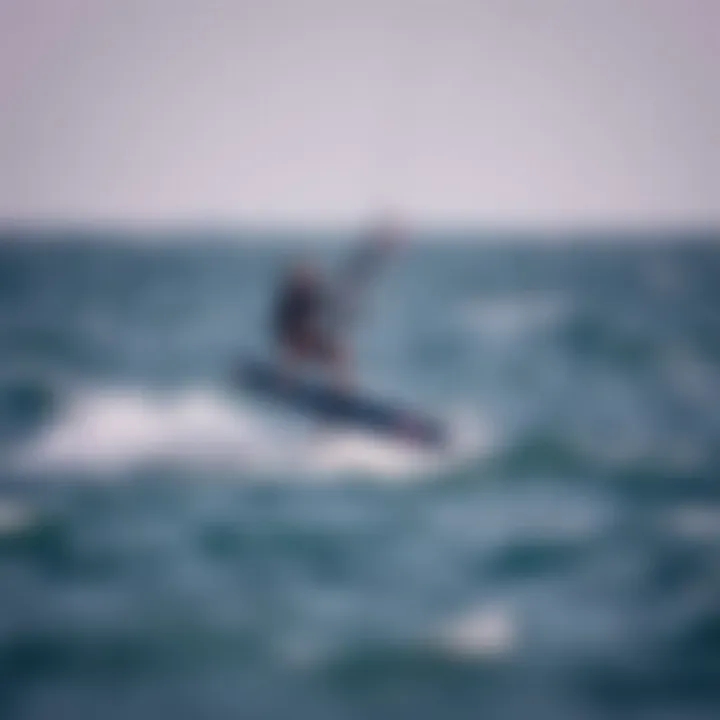
Intro
In the world of kiteboarding, the evolution of gear is nothing short of remarkable. One of the standout innovations in recent years is hydrofoil technology. By harnessing underwater lift, these devices enable riders to glide above the water's surface, virtually eliminating drag and transforming the experience of kiteboarding. For enthusiasts, understanding the workings of hydrofoils is not merely a novelty; it is the key to unlocking new levels of performance and enjoyment on the water.
Before we dive into the nitty-gritty, it's crucial for kiteboarders—both seasoned and newbies—to grasp why this technology is game-changing. Hydrofoils have revolutionized how we experience wind and waves, allowing for smoother rides, greater speeds, and, quite frankly, a bit of magic as the rider floats above the water. It is not just about riding; it is about experiencing the energy of nature in a way previously thought impossible.
This article aims to be a thorough resource, examining hydrofoil development, mechanics, and practical applications. So, strap in, as we explore the intricacies that make hydrofoil technology a staple for modern kiteboarding enthusiasts.
Prelims to Hydrofoil Technology
Hydrofoil technology has become a game changer in the world of kiteboarding, offering a unique blend of excitement and efficiency. For many enthusiastic kiteboarders and instructors, understanding what hydrofoils are and how they function is crucial for improving performance on the water. By reducing drag and increasing lift, hydrofoils allow riders to glide seamlessly, unlocking potential that standard boards can’t compete with. This section will explore the essence of hydrofoil technology, its significance in kiteboarding, and the pivotal factors that shape this innovative approach.
Definition and Basic Principles
At its core, a hydrofoil is a specialized wing-like structure that extends below the water’s surface. It operates on basic principles of physics—specifically, the relationship between lift and drag. As the hydrofoil moves through the water, it creates a pressure difference between the top and bottom of the foil, producing lift that elevates the board above the surface. This reduces the contact with water, allowing riders to achieve higher speeds with less effort.
This concept is not just theoretical; it has real-world applications. Riders report experiencing a feeling akin to flying, allowing them to access areas of water that are typically reserved for more ideal conditions. Here, the hydrofoil truly shines, enabling participants to engage in the sport even when the wind isn’t impressive. Furthermore, the sense of stability provided when riding on a hydrofoil makes it an attractive option for both beginners and seasoned experts.
Historical Context and Evolution
The story of hydrofoil technology is a fascinating one, dating back to the early 1900s. Originally designed for boats, the hydrofoil concept took decades to evolve before becoming a part of the kiteboarding mainstream. Milestones in its history include significant advancements in materials and engineering techniques, which have dramatically transformed the design and functionality of hydrofoils.
For instance, the breakthrough of using lightweight carbon fiber and other advanced materials has allowed for nimble designs that enhance performance. As kiteboarding gained popularity in the late 20th century, innovators began adapting hydrofoil concepts specifically for kiteboards. This evolution was not merely about adaptation; it was about creating a completely new sub-discipline that mixes skills, speed, and the pure thrill of riding above the water.
Mechanics of Hydrofoils
Understanding the mechanics of hydrofoils is crucial for kiteboarding enthusiasts looking to leverage the full potential of this technology. The interplay of forces and hydrodynamic principles creates the unique experience that hydrofoil riding offers. It is not just about getting up and gliding on the water's surface; it's about mastering how the hydrofoil interacts with the water, which is pivotal for performance, speed, and control.
A hydrofoil operates on principles deeply rooted in physics. The design, angle, and speed at which a hydrofoil moves through the water determine how effectively it generates lift and minimizes drag. Consequently, kiteboarders who grasp these mechanics will find themselves at an advantage, allowing for smoother rides, sharper turns, and greater stability.
There are several essential aspects to cover when delving into the mechanics of hydrofoils, and these include hydrodynamics, lift and drag forces. Each of these elements plays a pivotal role in understanding how to optimize performance on the water.
Hydrodynamics Explained
The term hydrodynamics refers to the behavior of fluids in motion, an essential aspect when it comes to hydrofoils. As a kiteboarder maneuvers across the water, the hydrofoil can lift above the surface, creating a nearly frictionless experience.
When a hydrofoil is submerged, water flows over the foil’s surface, and the shape of the foil determines how this water moves. It’s similar to how an airplane wing functions but optimized for water. The angle of attack, or the tilt of the foil related to the oncoming wave, drastically affects the amount of lift produced.
Factors such as the speed of the board and the angle at which the foil enters the water influence hydrodynamic lift significantly. Higher speeds typically yield more lift, allowing kiteboarders to glide effortlessly above the surface, cutting through small waves as if they were slicing bread. Furthermore, understanding how these dynamics shift in varying weather conditions can provide kiteboarders with a strategic advantage in variable surf.
"Understanding hydrodynamics is like learning to dance with the waves—knowing their rhythm can lead to a graceful performance."
Lift and Drag Forces
Two critical forces at play during hydrofoil operation are lift and drag. Lift is the force that propels the kiteboarder into the air, while drag is the resistance to motion. Each force must be carefully balanced to achieve optimal performance.
- Lift:
- Drag:
- Generated as water flows over and under the foil.
- It's vital to find the right angle of attack. Too steep, and the hydrofoil might stall; too shallow, and it won't lift.
- Lift increases with speed, making acceleration crucial for early ride initiation.
- Occurs due to water resistance in response to the foil's surface.
- Minimizing drag is essential for maintaining speed once lifted.
- Streamlined shapes and smooth finishes on the foil help reduce drag significantly.
Kiteboarders need to balance these two forces effectively. A well-tuned foil can provide the exhilaration of flying while ensuring that the rider remains safely in control. Understanding the nuances of how lift and drag function helps in selecting the right foil, tuning it properly, and mastering riding techniques. As riders refine their understanding of these mechanics, they unlock new levels of capability on the water.
Components of a Hydrofoil
Understanding the components of a hydrofoil is like grasping the pieces of a finely-tuned machine; each part plays its role in achieving that exhilarating ride above the water. The three primary elements are the foil design and shape, masts and fuselages, and board compatibility. This interplay between them determines both performance and usability in kiteboarding, allowing riders to make informed decisions on their gear for maximum enjoyment.
Foil Design and Shape
The design and shape of the foil are as crucial as a kite's fabric setup. Hydrofoils generally consist of a front wing, a rear wing, and a fuselage connecting these wings. Each aspect influences lift, drag, and how the board reacts to water conditions. For instance, a wider front wing provides more lift but might incur more drag. In contrast, thinner wings tend to be faster but require a more skilled touch to ride well.
Riding preferences also shape choices in foil design. Some kiteboarders favor dynamic swinging turns with slower speeds, while others chase top speeds across the water. Each scenario calls for different designs, which is why understanding the nuances in wing shapes—from high aspect ratios for speed to lower ratios for stability—is vital.
Masts and Fuselages
Masts and fuselages might seem like mere connectors, but they are the backbone of hydrofoil structure and performance. The mast length affects the ride's height above water; a longer mast can allow the rider to glide over chop, resulting in a smoother experience. Conversely, shorter masts can be more forgiving for those starting.
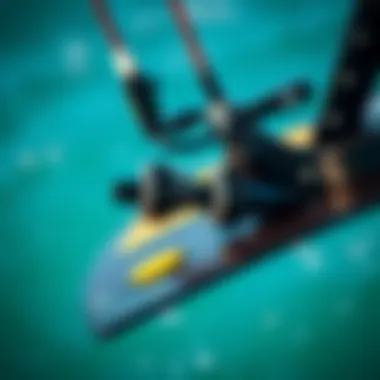
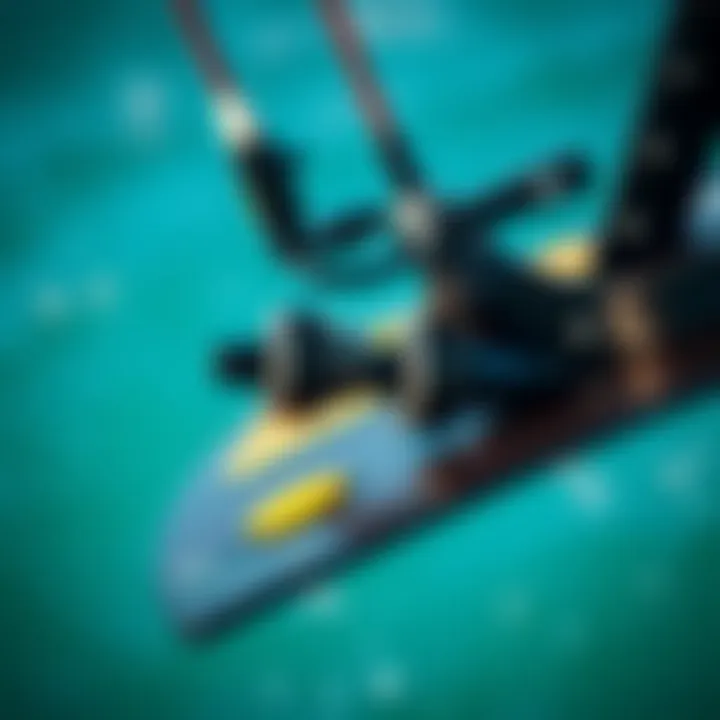
The fuselage bridges the wings to the mast and can vary in length. A longer fuselage can promote a more stable ride and allow for more effective energy transfer between the rider and the water. It also fosters better maneuverability, especially in rough waters. However, it can add extra drag, which is a consideration riders must evaluate when making gear choices.
Board Compatibility
Selecting the right hydrofoil setup must include consideration of board compatibility. Not every board works seamlessly with every foil. The mounting system, typically a set of tracks or plates, must align properly to ensure stability and performance. Some board designs may restrict certain foil placements, affecting the center of gravity and balance.
For example, a board designed for strapless riding may demand a different foil positioning compared to a board that's more oriented towards freestyle. Not only does rider preference play a role, but factors like the type of riding—freeride, racing, or surfing—also influence this compatibility.
Understanding these components allows kiteboarders to tailor their gear meticulously, akin to adjusting the strings on a finely tuned instrument. It’s essential for maximizing performance and enhancing enjoyment on the water.
"The right hydrofoil setup is paramount; it can make the difference between a smooth ride and a bumpy adventure."
In summary, when considering hydrofoil components, kiteboarders should take into account the interplay of foil design, mast and fuselage specifications, and board compatibility to tailor a setup that meets their needs and enhances their riding experience.
Types of Hydrofoils in Kiteboarding
Understanding the types of hydrofoils used in kiteboarding is essential for both beginners and seasoned riders. Each type brings specific advantages that align with various riding styles, conditions, and personal preferences. It's not as simple as just picking a hydrofoil off the shelf—knowing the characteristics of each type ensures that a rider can maximize their experience on the water. Here’s a closer look at the distinct types of hydrofoils and the unique benefits each one offers.
Freeride Hydrofoils
Freeride hydrofoils cater to those who prefer a blend of performance and ease of use. They are built for versatility, making them suitable for a range of conditions. The average freeride foil packs a punch when it comes to stability and maneuverability, which makes it a favorite among many riders.
The design of freeride hydrofoils often features a moderate aspect ratio, striking a balance between speed and lift. This allows riders to easily get up on the foil without requiring overly strong winds. Plus, the forgiving nature of these foils means they are less intimidating for newcomers.
- Ideal Conditions: Light to moderate wind, flat water to choppy conditions
- Rider Skill Level: Suitable for beginners to advanced users
- Key Benefit: Easy to control under a variety of conditions, promoting confidence in new riders
Race Foils
Race foils are engineered for pure speed and competitive performance. These foils often have a high aspect ratio, which reduces drag and enhances the efficiency of lift. In this setup, the foil can carve through the water more effectively, allowing experienced riders to reach impressive speeds.
These foils require a higher level of skill due to their sensitivity and the demand for precision in control. Small adjustments in body position can have a significant impact on performance, making them more suited to the competitive edge of experienced riders.
- Ideal Conditions: Strong winds, open water, or race courses
- Rider Skill Level: Advanced to expert riders
- Key Benefit: Maximized speed and efficiency, essential for competitive kiteboarding events
Surf Foils
Surf foils are designed to bridge the gap between traditional surfing and kiteboarding. They allow riders to catch and ride waves effortlessly. The unique shape and size of surf foils enable extremely smooth and stable rides on the water, making wave riding an exhilarating experience.
These foils typically have a more pronounced front wing, offering a larger lift surface. This design is particularly beneficial in less than ideal conditions, where maintaining lift can be challenging. Surf foils also provide excellent maneuverability, allowing for sharp turns and transitions.
- Ideal Conditions: Small to medium waves, surf zones
- Rider Skill Level: Intermediate to advanced, especially those interested in fusion of sports
- Key Benefit: Enjoyable wave riding experience, enhancing versatility in water sports
Wing Foil Integration
Wing foil�s have surged in popularity, riding the coattails of the hydrofoil revolution. These innovative setups combine a board, a hydrofoil, and a handheld wing. The incorporation of wing foiling into traditional kiteboarding expands on what is possible on the water, offering a new dimension of fun.
What makes wing foils particularly interesting is their adaptability. Riders can switch from traditional kiteboarding to wing foiling with minimal adjustments. In low wind conditions, wing foils can perform remarkably well, enabling riders to stay afloat with less kite power and harnessing the wind directly through the wing.
- Ideal Conditions: Varied wind conditions, from light to strong
- Rider Skill Level: All levels, but requires some adaptation due to wing dynamics
- Key Benefit: Gives a new experience of working with wind dynamics, encouraging freedom of movement
The diversity in hydrofoils illustrates the rich options available for kiteboarders today, ensuring everyone can find something that fits their style, conditions, and capability.
Advantages of Using Hydrofoils
When evaluating the world of kiteboarding, hydrofoils stand as a revolutionary component that elevates the experience of riders. Embracing hydrofoil technology brings forth a multitude of advantages that can transform not just the way one rides but the overall enjoyment and performance on the water. Let's delve into the specific benefits of hydrofoils, exploring how they change the game.
Enhanced Speed and Efficiency
Hydrofoils are designed to lift the board above the water, greatly reducing drag compared to traditional fin setups. This buoyancy allows kiteboarders to achieve remarkable speeds, often exceeding the typical limits experienced on a standard setup. Riders who have adopted hydrofoil technology usually notice the difference in how effortlessly they glide across the water. The lack of resistance translates to longer rides and less physical exertion—making it ideal for those wanting to cover significant distances without tiring too quickly.
Key characteristics of enhanced speed and efficiency include:
- Reduced water contact: When the board hydrofoils, only the wings remain submerged, minimizing friction.
- Optimal kite performance: With the board elevated, the kite is able to generate more lift and power, contributing to increased acceleration.
- Wider wind range: Hydrofoils allow kiteboarders to harness lighter winds effectively, thus maximizing the potential for ride even in less-than-ideal conditions.
Improved Maneuverability
Another hallmark of hydrofoil technology is improved maneuverability. The design of hydrofoils actually allows for smoother turns, faster direction changes, and more fluid transitions. Riders often describe the sensation of riding on a hydrofoil as “floating” rather than “slicing” through the water.
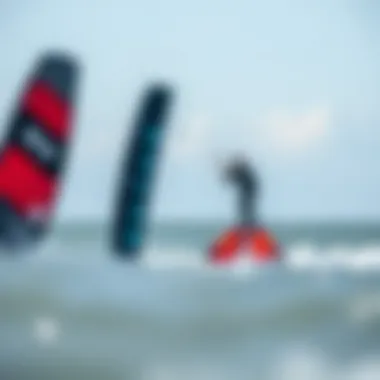
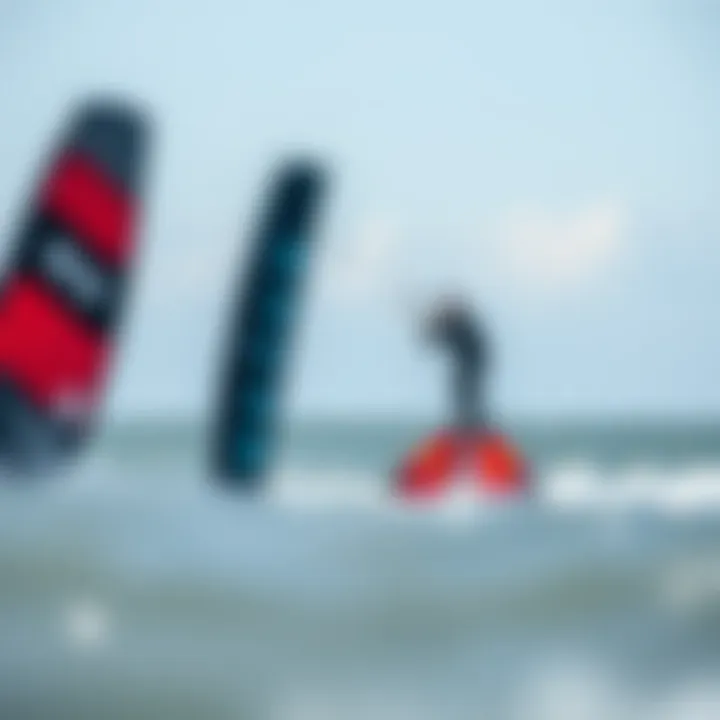
This type of performance is perfect for kiteboarders looking to make sharp movements, carve turns, or even fly just above the surface of the water. Particularly in waves or choppy conditions, the agility offered by hydrofoils provides a thrilling edge. The following aspects highlight maneuverability enhancements:
- Responsive turning capabilities: The reduced drag allows for quick and sharp turns, encouraging a playful riding style.
- Unique tricks and performance: Riders can now attempt more complex maneuvers that were difficult, if not impossible, with conventional setups, such as jumps, spins, and aerials.
- Dynamic adjustments: Hydrofoils can interact with water surfaces differently, making them adaptable to various conditions with ease.
Access to New Conditions
Hydrofoils give kiteboarders the ability to thrive in conditions that typically wouldn’t be ideal for regular kiteboarding. The technology opens new doors for adventurers who crave variety in their riding environments.
For instance, with hydrofoils, riders can explore shallower waters, venture into choppy marine environments, or take on these exhilarating scenarios:
- Shallow areas: Experience your kiteboarding session in locations where traditional boards would typically get stuck.
- Waves and rough seas: The hydrofoil can help mitigate the impact of rough waters, allowing riders to move fluidly.
- Low-wind days: Even in low-wind scenarios, hydrofoils perform well, keeping the momentum flowing smoothly.
In summation, incorporating hydrofoil technology in kiteboarding goes far beyond just another trend; it's about optimizing every ride. With an emphasis on improved speed, superior maneuverability, and expanded riding conditions, hydrofoils allow enthusiasts to elevate their kiteboarding experiences significantly. As technology continues to progress, kiteboarders will find even more opportunities to maximize their time on the water, exploring new terrains and refining their skills like never before.
This continuous evolution in hydrofoil technology pushes the boundaries of what kiteboarding can be, encouraging innovation and adventure in equal measure.
For more insights into kiteboarding techniques and gear, check out Wikipedia or participate in discussions on platforms like Reddit.
Choosing the Right Hydrofoil
Selecting the right hydrofoil is more than just picking the newest shiny piece of gear off the rack; it's about ensuring compatibility with your skill level, riding conditions, and budget. The nuances involved in these choices can significantly influence your experience on the water. Here's a closer look at the essential factors to consider for making an informed decision.
Skill Level Considerations
When considering a hydrofoil, your skill level stands at the forefront. Novice riders might find larger, more stable foils easier to handle. These typically offer more lift and allow for smoother rides over various water conditions. At the same time, this can lead to a bit more drag. So, it's somewhat of a double-edged sword.
For intermediate and advanced kiteboarders, the choices open up considerably. They may opt for smaller foils that are nimble and responsive, suited for high-performance riding. However, this also means more expertise is required to master control.
"A wise kiters knows when to go big and when to go home."
Take the time to assess your comfort level and the amount of time you've spent honing your skills. If you’re still getting the hang of things, there's no shame in opting for a beginner-friendly hydrofoil.
Riding Conditions and Preferences
The riding conditions play a pivotal role in the selection process. If you’re often out in light winds, a hydrofoil with a larger surface area will help you take off and stay up without needing strong gusts. However, if you're dealing with rough, choppy water, you may want something more versatile that can maintain stability.
Additionally, consider your riding style. Are you more into freeriding, or do you thrive in race conditions? Do you prefer wave riding, or is flat water your playground? Choices vary based on these factors:
- Freeride Foils: Often accommodate a range of conditions and are user-friendly.
- Race Foils: Designed for speed and responsiveness, best used in controlled conditions.
- Surf Foils: Typically smaller, suited for wave conditions.
- All-rounders: Great for those wanting to dabble in multiple styles without specialized gear.
Budget and Quality Balance
Last but not least, the delicate dance between budget and quality can be challenging. A high-quality hydrofoil often comes with a heftier price tag. However, investing in a good piece of equipment can pay off in durability and performance.
- Entry Level Options: These may be more affordable but can compromise on long-term performance. Great for beginners dipping their toes in.
- Mid-Range Choices: Balance between quality and price. Solid investment for intermediate users who want reliability without breaking the bank.
- Premium Gear: Best suited for advanced riders who are perhaps professionals or individuals committed to the sport and seeking every edge.
Finding that sweet spot requires research and often firsthand experience from other riders. Engaging in discussions on platforms like Reddit or local kiteboarding forums could be invaluable in gathering insight about what's working best in your community.
Maintenance and Care for Hydrofoils
Taking care of your hydrofoil is as essential as knowing how to ride it. Just like a kite or board, a hydrofoil can wear down over time if it’s not properly maintained. Neglecting this can lead to larger problems down the line—think repairs that could’ve been avoided altogether. Proper maintenance can lengthen the life of your equipment and enhance performance, so it's essential to incorporate good practices.
Cleaning and Inspection
Cleaning your hydrofoil might seem like a mundane task, but it is vital for maintaining efficiency and safety. Saltwater and sand can do a number on the materials used in manufacturing hydrofoils if not dealt with promptly. Here are some points to remember:
- Rinse Immediately After Use: A simple fresh water rinse directly after your session can help prevent build-up of salt and grit. It will also keep the foil looking spick and span.
- Inspect for Damage: While cleaning, take a moment to inspect surfaces, edges, and connections for signs of wear. Cracks or dents can lead to significant issues when you hit the water again.
- Use a Soft Cloth: For tougher spots, use a soft cloth or sponge to avoid scratching the finish of your foil.
- Check Hardware: Ensure screws and bolts are not too loose. A quick tighten can save you from a malfunction later.
"Regular maintenance is not just about preserving your kit, it's also about maximizing your time on the water—every minute counts!"
Establishing a routine for cleaning and inspecting your hydrofoil can ease any concerns about sudden performance drops or mechanical failures.
Storage Recommendations
When the day of riding is over, how you store your hydrofoil is just as important as how you maintain it. Improper storage can lead to warping or damage that could seriously affect your next ride. Here are best practices:
- Dry Before Storing: Be sure to dry everything thoroughly, especially the foil and the board. Mold and corrosion love damp places.
- Use a Protective Bag: Consider investing in a protective bag or cover designed for hydrofoils. Not only do these minimize space in your car or garage, but they also shield against dust and physical damage from bumps.
- Store in a Climate-Controlled Space: If possible, keep your hydrofoil in a cool, dry space. High heat or extreme cold can warp materials over time, drastically impacting performance.
- Avoid Extreme Weight Loads: Don’t stack heavy objects on top of your hydrofoil when storing it. Ensure it's laid flat and won't be squashed or pressed.
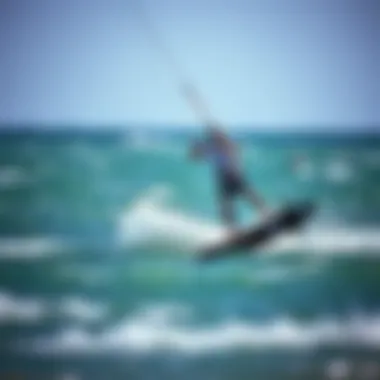
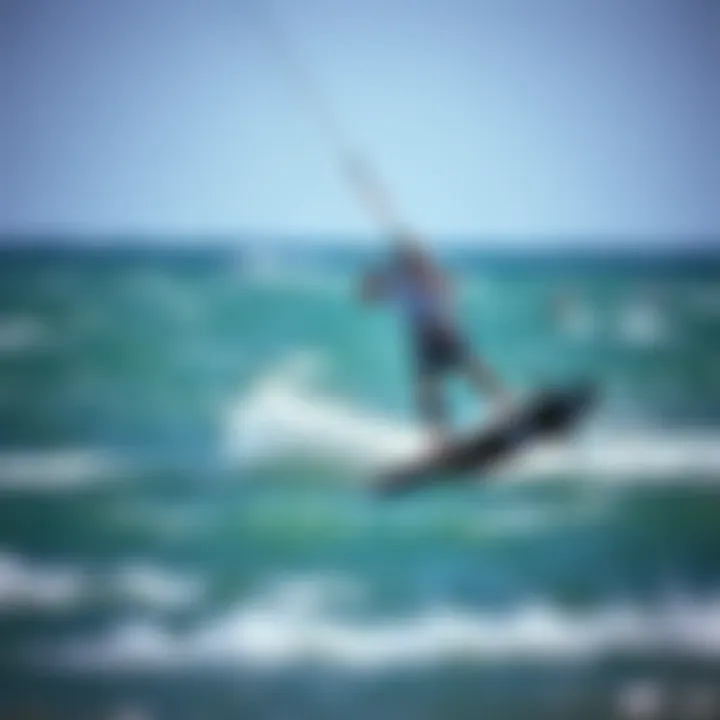
With just a little attention to cleaning and storage practices, you can ensure that your hydrofoil remains in top-notch condition for each kiteboarding adventure. By protecting your investment, you ensure longer rides, better performance, and run less risk of equipment failure.
Performance Enhancement Techniques
Mastering hydrofoil technology does not stop at merely mounting a board and hoisting a kite; it extends into the realm of fine-tuning your setup and harnessing effective riding techniques. Performance enhancement techniques can significantly elevate your experience and efficiency on the water. This section will discuss two crucial aspects: tuning and adjustments, as well as riding techniques for better efficiency.
Tuning and Adjustments
Tuning your hydrofoil is akin to a musician tuning their instrument before a performance. It ensures all components work harmoniously, maximizing your ride quality and enjoyment. Proper adjustments can lead to smoother flights and enhanced responsiveness. Here are some key considerations:
- Wing Angle: The angle at which your hydrofoil wing is mounted affects lift and drag. Adjusting this angle can make a profound difference in how quickly you take off and how high you can fly above the water.
- Foil Height: The height adjustment of the foil itself impacts both stability and speed. A higher position generally means more speed, but it can also increase risk if conditions are choppy. Therefore, find a balance that matches your skill level and the prevailing conditions.
- Weight Distribution: Where you stand on your board needs to be intentional. Shifting your weight slightly forward or backward can alter the dynamics, impacting how well your foil slices through the water.
Incorporating these tuning adjustments requires patience and practice. Don’t shy away from experimenting in varying wind conditions and water states; you will learn what works best for you over time.
Riding Techniques for Efficiency
Once your hydrofoil is nicely tuned, the next step is mastering your riding techniques. Efficiency in movement not only improves performance but enhances comfort and prolongs your energy reserves.
- Smooth Transitions: When changing from one direction to another, strive for fluid, smooth movements. Abrupt shifts can disrupt the lift and may lead to crashes or control loss.
- Kite Control and Position: Keep your kite at an optimal angle depending on your speed and intent. Higher angles can facilitate more lift, ideal for aggressive maneuvers, while lower angles help with more stable, controlled rides.
- Body Positioning: Engage your core and bend your knees slightly; a well-centered position helps in maintaining balance and reacts fluidly to the water’s surface. Use your upper body to steer subtly, preserving energy.
"Mastering hydrofoil techniques is not just about the gear; it's about understanding how to ride smartly on the water."
Practicing these techniques regularly will lead to improved performance, allowing you to focus on enjoying the thrill of kiteboarding. Remember, every kiteboarder is on their own journey; learning and refinement are part of the adventure.
Hydrofoil Community and Resources
The evolution of hydrofoil technology in kiteboarding doesn't happen in a vacuum. Just as a kite's performance relies on wind and water conditions, so too does the advancement of hydrofoil technology depend significantly on the community surrounding it. This section shines the spotlight on the hydrofoil community and its resources: a vibrant network where enthusiasts share knowledge, experiences, and innovations. This engagement often leads to the latest techniques, tips, and improvements in design that can enhance the sport for everyone involved.
Online Forums and Groups
Online forums and groups are crucial hubs for kiteboarding enthusiasts looking to immerse themselves in hydrofoil discussions. Platforms like Reddit and Facebook have numerous dedicated groups where both novices and seasoned riders come together to swap stories and advice.
In these spaces, individuals can ask questions ranging from the basic to the advanced, often receiving answers from those who've had hands-on experience. They offer a sense of belonging, which is vital for many who pursue these thrilling water sports. You might find threads tackling subjects such as how to optimize your board's setup, or debates over the best materials for constructing a foil.
Moreover, these communities often keep tabs on emerging trends and innovations. When a new hydrofoil model hits the market, discussions erupt about its merits and shortcomings, providing valuable consumer insights.
Some popular platforms that are worthy of a visit include:
Events and Competitions
The vibrant aspect of the hydrofoil community extends beyond the digital realm, showcasing itself dynamically during events and competitions. These gatherings not only celebrate outstanding kiteboarding talents but also serve as a meeting ground for learning and networking. Participants can observe and discuss the latest gear, and even witness first-hand the improvements in hydrofoil technologies amassed over time.
Competitions often become showcases for innovation, with many participants taking the opportunity to debut custom-designed hydrofoils. These events can be instrumental in inspiring others to push their limits or consider new additions to their setups.
Additionally, workshops and demo days are common at these gatherings. Here, attendees can get hands-on experience with new products and guidance from experts on optimizing performance.
To keep an eye out for upcoming events, consider checking out:
- World Kiteboarding League
- Various regional kiteboarding competitions
The commitment to sharing knowledge, celebrated through events and strengthened by online interactions, creates a robust framework for hydrofoil riders seeking to advance in the sport. Having access to these resources allows riders not just to learn but to evolve, making the journey with hydrofoils even more thrilling.
Future of Hydrofoil Technology
The future of hydrofoil technology in kiteboarding represents a significant evolution in the sport. As kiteboarders seek to enhance their experience on the water, the advancements in hydrofoils promise to reshape how enthusiasts engage with this thrilling pursuit. By examining future trends and innovations, we can uncover how these changes will not only improve performance but also expand the horizons of kiteboarding.
Innovations in Design and Materials
One of the most striking features of the future of hydrofoil technology is the constant innovation in design and materials. This isn't just about slapping a wing onto a board; it’s about increasing efficiency while maintaining durability and weight considerations. For instance, the use of carbon fiber has become prevalent due to its strength-to-weight ratio. The liberation that comes from employing lighter materials allows for agility and will enable riders to tackle more challenging conditions with ease.
Additionally, designs that incorporate biomimicry are gaining traction. Foils inspired by marine life, such as fish or bird wings, can exhibit remarkable efficiency. These innovations focus on optimizing lift and reducing drag, allowing kiteboarders to glide effortlessly on the water. Just imagine a hydrofoil that, on a flat ocean surface, can take off at lower wind speeds while offering enhanced control—this is quickly becoming reality.
"The shift in hydrofoil design toward lighter materials enhances maneuverability without compromising strength, changing how we kiteboard forever."
Trends in Kiteboarding
As hydrofoil technology evolves, noticeable trends are emerging within the kiteboarding community. Riders are no longer confined to traditional setups. The rise of all-terrain kiteboarding showcases how hydrofoils empower riders to explore varied environments—from flat lakes to waves and even choppy conditions. This versatility prompts kiteboarders to adapt their techniques, engaging with the water in ways previously thought to be unimaginable.
Meanwhile, the community is witnessing a growing interest in environmental sustainability. Kiteboarders are aligning with brands that prioritize eco-friendly materials and manufacturing processes. As environmental consciousness grows, companies that invest in sustainable practices are appealing to consumers who are passionate about preserving the waters they love.
In summary, hydrofoil technology is not just a trend but a transformation that influences every facet of kiteboarding. The innovations in materials, designs that embrace nature, and the shift towards sustainable practices all signal a revolution within the sport. With these advancements unfolding, kiteboarding enthusiasts can look forward to a future rich with possibilities.
